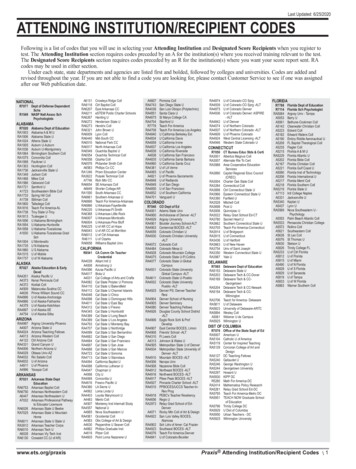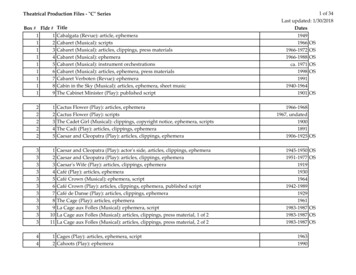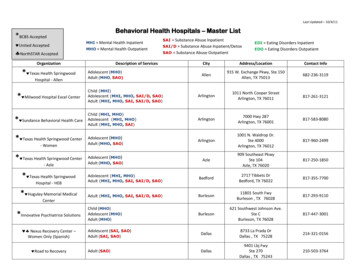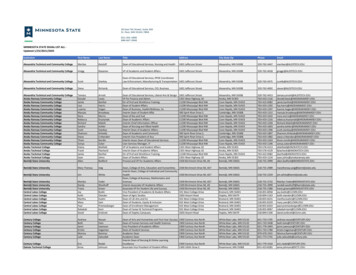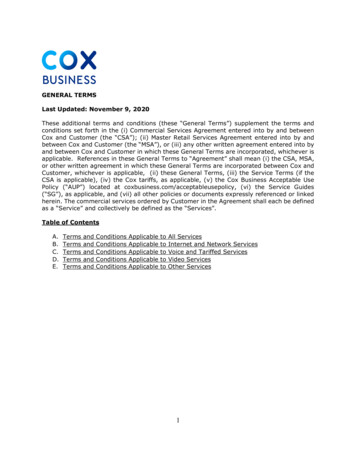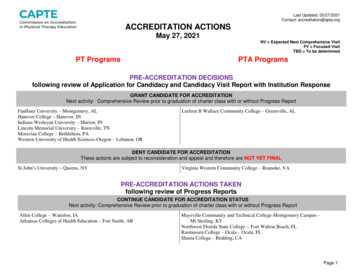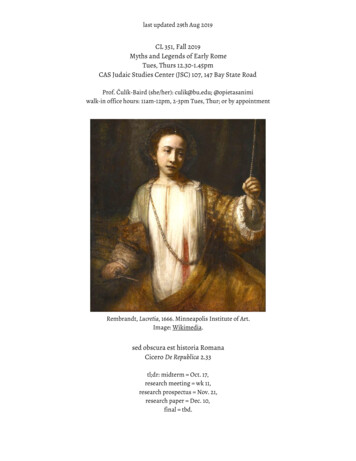
Transcription
last updated 29th Aug 2019CL 351, Fall 2019Myths and Legends of Early RomeTues, Thurs 12.30-1.45pmCAS Judaic Studies Center (JSC) 107, 147 Bay State RoadProf. Čulík-Baird (she/her): culik@bu.edu; @opietasanimiwalk-in office hours: 11am-12pm, 2-3pm Tues, Thur; or by appointmentRembrandt, Lucretia, 1666. Minneapolis Institute of Art.Image: Wikimedia.sed obscura est historia RomanaCicero De Republica 2.33tl;dr: midterm Oct. 17,research meeting wk 11,research prospectus Nov. 21,research paper Dec. 10,final tbd.
Course description and aims: In this class we study the stories told by the Romans about their earliesthistory, from Aeneas to Cloelia. By the end of the class your knowledge of the Latin language will deepenand your research skills will be greatly sharpened.A disclaimer. While the literature, art, and mythology of the cultures of the ancient mediterranean arefascinating and often inspire us, the values and social practices of those societies can be very far fromour own. The following were regular motifs in Greek and Roman storytelling: enslavement, sexualviolence, murder, suicide, incest, abduction, cannibalism, bodily mutilation. Sexual violence, abduction,and rape of women is particularly prominent in the literature which we will be translating in this class.Please be forewarned that we will sometimes be discussing very sensitive topics, which may bechallenging to some students. Our study of these narratives is not an endorsement of their perspectives.What I expect of you: Come to class having translated the assigned Latin. In class, you will be calledupon to translate; you may use your notes, but you may not read from a prepared translation. Read andmakes notes on the secondary readings (i.e. the scholarship: journal articles, book chapters, etc.); we willdiscuss these together in class, and you will use the notes you take along the way to write your researchpaper at the end of the semester. It is very possible that you will not always have time to do all of theassigned readings - this is fine! Do what you can with the time you have.Required texts: You are not required to buy any books for this class (although you should get a goodLatin dictionary and a good grammar if you don’t already have them, see below). However, if you wantto read in English more of the texts which we’ll be translating I recommend: Livy: The Early History ofRome, translated by Aubrey de Sélincourt with notes by Robert Ogilvie (ISBN: 0140448098); and: Ovid:Fasti, translated by A. J. Boyle and Roger Woodard (ISBN: 0140446907). See the bibliography at the end ofthis syllabus for further readings (all available from Mugar Memorial Library, or via jstor).Exams and assignments: Participation [30%] preparation for class [15%] participation in class [15%] Exams [45%] Midterm Latin translation comment [20%], Thurs 17th Oct. Final Latin Translation comment [25%], tbd Research paper (8-10 pages), [25%; of which 5% prospectus] due Tues 10th DecemberResources on Latin grammar, syntax, vocabulary. For this class, you will need: A Latin-English dictionary: Lewis and Short can be consulted online via Logeion (https://logeion.uchicago.edu/) or Perseus project (http://www.perseus.tufts.edu/hopper/morph?), or inphysical format. Other respectable dictionaries are: Cassell’s (ISBN: 0025225804), Chambers Murray(ISBN: 0550190031), and Langenscheidt (ISBN: 0887291074). A grammar: In the US, the standard is Allen and Greenough’s Latin Grammar (ISBN: 0486448061). Youcan get a physical book copy, or use DCC commentaries’ online version: http://dcc.dickinson.edu/allen-greenough/. In the UK, the standard is Kennedy’s Latin Primer (ISBN: 0582362407).
Exams: For your midterm (17th Oct.) and final (tbd) exams, you will translate a passage of Latin whichwe will have read and discussed together in class. You will have a choice of passages (complete 1 out of achoice of 2). In addition to your translation, you will be asked to comment on the significance of thepassage, picking out 3 points of interest. The final will not be cumulative, but it will be slightly longer.Research paper: In addition to your midterm and final exams, you will complete a research paper (8-10pages) on a question of your choice. In wk 11, you will meet individually with me to discuss your paperidea; you will submit a 200-300 word prospectus on Nov. 21st. Your prospectus will identify your topic,the primary texts you intend to discuss, and will include a short bibliography. Format all papers doublespaced with Times New Roman, 12-point font, 1” margins. Papers must be printed and handed in (notemailed) on the stated date. All papers MUST include references to primary and secondary sources. DueTues. 10th December.BU Hub: This course fulfills a single unit in the following BU Hub areas: Aesthetic Exploration Historical Consciousness Research and Information LiteracyOffice hours: My office hours are the hours in the week specifically set aside for you to come and talk tome one-on-one (or in small groups if you prefer). My door is open to you during the regular hours (Fall2019: 11am-12pm, 2-3pm Tues, Thur), but if those times don’t work, you can email me to schedule aspecific time.Lateness & Academic Integrity: All work is due on the dates specified except in case of emergency. If youare unable to attend an exam due to such an emergency, you must contact asap. Violations of academicconduct (such as plagiarism) will be reported to the Dean. For the code, see: onduct-code/. Plagiarism is a serious offence, and benefits no one. Ina class like this one, plagiarism includes: pretending that someone else’s translation is your own;insufficiently crediting secondary scholarship. If you are ever in a crisis and are tempted to plagiarize,come speak to me instead!Disability & Accommodation:Any student requesting accommodations based on disability should contact BU’s Disability Services:http://www.bu.edu/disability/
SCHEDULE OF READINGSThe instructor reserves the right to make changes as she sees fit.You must always bring your text with you to class.Wk 1Tues 3rd Sept. Introductions.Thurs 5th Sept. The mists of time: Livy’s preface. Read: Introduction to Livy; Ogilvie, Livy: The Early History of Rome (Penguin), pp1-25. Read in English: Livy’s preface (trans. by de Sélincourt, pp29-31). Read: T. J. Cornell, “Traditional History: Kings, Queens, Events, and Dates,” in The Beginnings of Rome(1995), pp119-150. Optional (but recommended): G. Forsythe, “Rome during the Regal Period,” in A Critical History of EarlyRome (2005), pp78-124 [online via Mugar]Wk 2Tues 10th Sept. Roman beginnings, Trojan ends: Aeneas. Translate: Livy 1.1. Read in English: Aeneas in the Iliad (2.819-823; 5.166-178; 20.283-317); Vergil’s Aeneid 2.705-711. Read: T. J. Cornell, “The Origins of Rome,” in The Beginnings of Rome (1995), pp63-68.Thurs 12th Sept. Aeneas and Lavinia. Translate: Livy 1.2-3. Read: Ursula K. Le Guin, Lavinia (2008), pp3-5. Read in English: Vergil’s Aeneid 7.71-80, 12.64-70. Read: J. de Luce, “Reading and re-reading the helpful princess,” in Compromising Traditions, pp 25-37; K.Galinsky (1969), “Lavinium and Rome,” in Aeneas, Sicily, and Rome, pp141-190. Optional: T. S. Miller, “Myth-remaking in the shadow of Vergil: the captive(-ated) voice of Ursula K. LeGuin’s Lavinia.” [https://bit.ly/2zr3G5S]Wk 3Tues 17th Sept. Ilia and Mars. Translate: Livy 1.3-4; Ennius Annales (Skutsch 34-50); Ovid Amores 3.6.45-82. Read in English: Dionysius of Halicarnassus, Roman Antiquities (1.76-78): Dionysius of Halicarnassus/1D*.html Read: C. Connors, “Ennius, Ovid, and Representations of Ilia.” Materiali e discussioni per l'analisi dei testiclassici (1994), pp. 99-112 [jstor]; J. Elliott, “The voices of Ennius’ Annales,” in Ennius Perennis, The Annalsand Beyond (2007), pp38-54; A. Keith, “Over her dead body,” in Engendering Rome (2000), pp101-131[online via Mugar].
Thurs 19th Sept. The twins and the wolf. Translate: Livy 1.4; Ovid Fasti 2.381-422. Read in English: Dionysius of Halicarnassus Roman Antiquities 1.79: Dionysius of Halicarnassus/1D*.html; Plutarch, Life of Romulus 3-4, 6: Plutarch/Lives/Romulus*.html Read: T. J. Cornell, “The Origins of the Legends: Romulus and Remus,” in The Beginnings of Rome (1995),pp60-63; T. P. Wiseman, “Reviewed Work: She-wolf: The story of a Roman Icon by C. Mazzoni,” in JRS(2012), pp321-322 [jstor].Wk 4Tues 24th Sept. Rome or Remora? Translate: Livy 1.6-7, Ennius Annales (Skutsch 72-91), Suet. Augustus 7. Read in English: Dionysius of Halicarnassus Roman Antiquities 1.85-87: Dionysius of Halicarnassus/1D*.html; Plutarch Life of Romulus 9-11: Plutarch/Lives/Romulus*.html G. Forsythe, “Appendix: Early Roman Chronology,” in A Critical History of Early Rome (2005), pp369-370.Thurs 26th Sept. “The blood curse.” Translate: Ovid Fasti 4.807-862. Read in English: Cicero De Officiis 3.40-41; Horace Epode 7 with Boyle-Woodard (2004), xl-xli. Read: C. J. Bannon, “Romulus and Remus reconsidered,” in The Brothers of Romulus: Fraternal “Pietas” inRoman Law, Literature, and Society (1997), pp158-173 [online via Mugar].Wk 5Tues 1st Oct. Rape of the Sabine Women I. Translate: Livy 1.9, 13; Propertius 2.19-22. Read in English: Cicero De Republica 2.12-13, Vergil Aeneid 8.626-637. Read: T. J. Cornell, “The Sabines and Early Rome,” in The Beginnings of Rome (1995), pp75-77; R. Brown(1995), “Livy’s Sabine Women and the Ideal of Concordia,” in TAPA Vol. 125, pp291-319 [jstor]Thurs 3rd Oct. Rape of the Sabine Women II. Translate: Ovid Ars Amatoria 1.89-134, Ovid Fasti 3.179-228. Read in English: Dionysius of Halicarnassus Roman Antiquities 2.30-33: Dionysius of Halicarnassus/2B*.html; Plutarch Life of Romulus 14-20: Plutarch/Lives/Romulus*.html Read: C. Conners (2013), “The Sobbin’ Women: Romulus, Plutarch, and Stephen Vincent Benét.” IllinoisClassical Studies No 38, pp127-148 [jstor] clip of the “Sobbin' Women” in Seven Brides for Seven Brothers(1954): https://www.youtube.com/watch?v bAOypbgayOoWk 6
Tues 8th Oct. Tarpeia and Tatius. Translate: Livy 1.11, Propertius 4.4. Read: M. Fox, 1996, “The Regal Period in Propertius 4,” in Roman Historical Myths, pp142-181.Thurs 10th Oct. Romulus disappears ? Translate: Livy 1.16, Ovid Fasti 2.475-509, Read in English: Ovid Metamorphoses 14.805-851. Read: P. Hardie, 2002. “The Historian in Ovid. The Roman History of Metamorphoses 14-15.” In Clio andthe Poets. pp191-210 [online via Mugar]; T. P. Wiseman, 1983. “The Wife and Children of Romulus,” CQVol. 33, pp445-452. [jstor]Wk 7Tues 15th Oct. “BU Monday” - no classThurs 17th Oct. MIDTERMWk 8Tues 22nd Oct. Numa and Egeria. Translate: Livy 1.19, Ovid Metamorphoses 15.1-11, 15.479-496, Ovid Fasti 3.151-166. Read in English: Cicero De Republica, 2.24-29; Juvenal 3.10-20; Dionysius of Halicarnassus RomanAntiquities 2.60-61: Dionysius of Halicarnassus/2C*.html; Plutarch Life of Numa 4-5: Plutarch/Lives/Numa*.html Read: A. Deremetz, “Numa in Augustan Poetry,” in J. Farrell and D. P Nelis (eds.) Augustan Poetry andthe Roman Republic (2013), pp228-243 [online via Mugar].Thurs 24th Oct. Č-B away - class cancelledWk 9Tues 29th Oct. The Horatii and the Curiatii. Translate: Livy 1.24, 25-26. Read in English: Dionysius of Halicarnassus Roman Antiquities 3.18-21: Dionysius of Halicarnassus/3A*.html Read: Solodow, J.B. “Livy and the Story of Horatius, 1.24-26.” TAPA, Vol. 109 (1979), pp251-268 [jstor]; S.P. Oakley, “Dionysius of Halicarnassus and Livy on the Horatii and the Curiatii,” in AncientHistoriography and its Contexts (2010), pp118-138 [online via Mugar]Thurs 31st Oct. Tanaquil and Tarquinius Priscus. Translate: Livy 1.34-35.
Read in English: Cicero De Republica 2.34-37; Dionysius of Halicarnassus Roman Antiquities n/Texts/Dionysius of Halicarnassus/3A*.html Read: L. Shipley, “To be a woman,” in The Etruscans: Lost Civilizations (2017), pp95-108; C. Claassen, “TheFamiliar Other: The Pivotal Role of Women in Livy’s Narrative of Political Development in EarlyRome,” Acta Classica, Vol. 41 (1998), pp71-103 [jstor]; G. Meyers, “Tanaquil: The Conception andConstruction of an Etruscan Matron,” in A Companion to the Etruscans (2015), pp305-21 [online viaMugar]; A. K. Michels, “The Drama of the Tarquins,” Latomus (1951) T. 10, Fasc. 1, pp13-24 [jstor]Wk 10Tues 5th Nov. Servius Tullius. Translate: Livy 1.39-40, Ovid Fasti 6.627-636. Read in English: Cicero De Republica 2.37-38; Dionysius of Halicarnassus Roman Antiquities 4.1-2: Dionysius of Halicarnassus/4A*.html Read: T. J. Cornell, “Who was Servius Tullius?” in The Beginnings of Rome (1995), pp119-141; for a long (butgood) discussion of the Servius Tullius/Mastarna issue: R. Thomsen, “Origin,” in King Servius Tullius(1980), pp57-114.Thurs 7th Nov. Tullia and Tarquinius Superbus. Translate: Livy 1.46-47, 48. Read in English: Dionysius of Halicarnassus Roman Antiquities 4.28-40: Dionysius of Halicarnassus/4B*.html Read: W. L. Godshalk “Livy’s Tullia: A Classical Prototype of Lady Macbeth,” Shakespeare Quarterly, Vol.16, Iss. 2 (1965) pp240-241 [jstor]; D. C. Gabbard, “‘The She-Tyrant Reigns’: Mary II and the TulliaPoems,” Restoration Vol. 25, No. 2 (2001), pp103-116.Wk 11: RESEARCH MEETINGSTues 12th Nov. The Rape of Lucretia I.
In the UK, the standard is Kennedy’s Latin Primer (ISBN: 0582362407). Exams: For your midterm (17th Oct.) and final (tbd) exams, you will translate a passage of Latin which we will have read and discussed together in class. You will have a choice of passages (complete 1 out of a choice of 2). In addition to your translation, you will be asked to comment on the significance of the passage .


